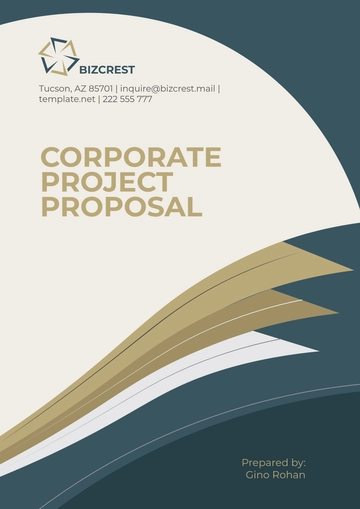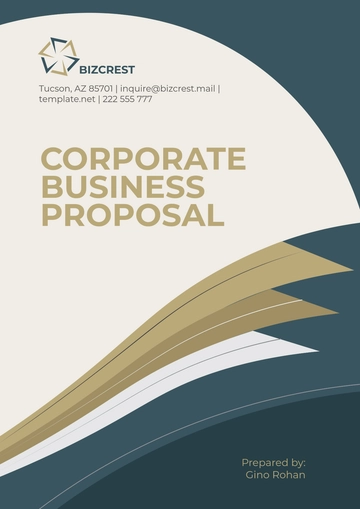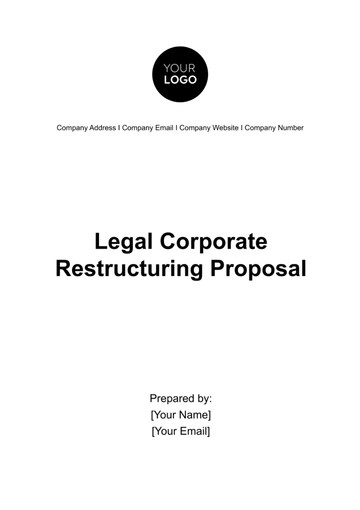Free Legal Corporate Restructuring Proposal

I. Executive Summary
This proposal outlines a comprehensive and strategic plan aimed at transforming our organization for increased efficiency, profitability, and long-term sustainability. The proposal encompasses a thorough review of our organizational structure, an in-depth assessment of business processes, and a detailed evaluation of our debts and assets. The primary objectives of this restructuring proposal are to decrease operational costs, improve internal control measures, maximize shareholder value, and enhance organizational flexibility.
The proposal also provides a clear timeline and budget for the restructuring process, ensuring transparency and effective resource allocation. It highlights the manifold benefits of the restructuring process, including increased operational efficiency, improved financial stability, enhanced organizational flexibility, and long-term sustainability. It also acknowledges the potential risks associated with the restructuring process and outlines strategies to mitigate these risks. This proposal represents a significant investment in the future of our organization, setting us on a path towards increased efficiency, profitability, and long-term success.
II. Objectives
The primary objectives of this restructuring proposal are:
A. Decrease Operational Costs
Decreasing operational costs is a key objective of this restructuring proposal. This involves streamlining processes to eliminate redundancies and optimize resource allocation. By doing so, we aim to reduce the financial burden on the company and increase profitability.
B. Improve Internal Control Measures
Improving internal control measures is another crucial objective. This involves implementing robust audit and compliance systems and enhancing transparency and accountability.
C. Maximize Shareholder Value
Maximizing shareholder value is a fundamental objective of this restructuring proposal. This involves improving financial performance and increasing dividend payouts. By doing so, we aim to increase the return on investment for shareholders.
D. Enhance Organizational Flexibility
Enhancing organizational flexibility is a key objective of this restructuring proposal. This involves fostering a culture of innovation and adaptability and enabling quick decision-making and rapid response to market changes.
III. Methodology
The methodology for this restructuring proposal is designed to be comprehensive and thorough, ensuring that all aspects of the organization are considered.
A. Comprehensive Review of Organizational Structure
The first step in our methodology involves a comprehensive review of the current organizational structure. We will also assess the effectiveness of the current structure in meeting the company’s objectives. This will involve evaluating whether the current structure facilitates effective decision-making, promotes collaboration, and supports the achievement of the company’s strategic goals.
B. In-depth Assessment of Business Processes
The next step involves an in-depth assessment of the company’s business processes. We will map out the current business processes within the organization to understand how work is currently being done. We will then identify bottlenecks and areas of inefficiency where improvements can be made. This includes streamlining processes, automating tasks, or reassigning responsibilities. The goal is to optimize these processes to increase efficiency and effectiveness.
C. Detailed Evaluation of Debts and Assets
The final step involves a detailed evaluation of the company’s existing debts and assets. This will involve analyzing the company’s balance sheet, income statement, and cash flow statement. We will then identify opportunities for debt consolidation or asset liquidation to improve the company’s financial position. This could involve negotiating with creditors, selling off non-core assets, or restructuring the company’s debt.
IV. Scope
The scope of the restructuring process is comprehensive and all-encompassing. It will incorporate a thorough revamp of management roles, operational processes, and company policies. This revamp is designed to ensure that the organization is structured and operates in a way that is most conducive to achieving its objectives. In addition to revamping roles, processes, and policies, the restructuring process will also involve the development of debt consolidation strategies and risk management procedures. These strategies and procedures are designed to ensure the company’s financial health and resilience in the face of potential risks and uncertainties.
The scope of the restructuring process is not limited to the internal workings of the organization. It also takes into account the external business environment and how changes in this environment may impact the organization. This includes changes in the market, industry trends, regulatory changes, and other external factors that may affect the organization’s operations. This comprehensive approach will ensure that all aspects of the organization are considered and that the restructuring process leads to meaningful and sustainable improvements. It is through this comprehensive and holistic approach that we aim to transform the organization and set it on a path towards long-term success and sustainability.
V. Timeline
The restructuring process is a complex undertaking that requires careful planning and execution. The following table outlines the proposed timeline for the restructuring process:
Activity | Duration |
|---|---|
Review & Assessment | January - March |
Strategy Proposal | |
Implementation & Monitoring | |
Review & Adjustment |
The first phase of the restructuring process, the Review & Assessment, is scheduled to run from January to March. This phase involves a comprehensive review of the current organizational structure and operations. It is during this phase that we will gather the necessary insights to inform the development of the restructuring strategy.
The Review & Assessment phase is crucial as it sets the foundation for the entire restructuring process. It allows us to understand the current state of the organization and identify areas that need improvement. The insights gained from this phase will guide the development of the restructuring strategy and ensure that it is tailored to the specific needs and challenges of the organization.
The importance of having this clear and well-defined timeline for the restructuring process cannot be overstated. It provides us with a roadmap for the process, ensuring that all activities are planned and executed in a timely and efficient manner. It also allows stakeholders to track the progress of the restructuring process and ensures that all activities are aligned with the overall objectives of the restructuring.
VI. Budget
The budget is a critical component of the restructuring proposal. It provides an estimate of the expected costs associated with the different areas of the restructuring process. The following chart provides an overview of these costs:
The initial phase of the restructuring process is the review and assessment stage. This stage is crucial as it sets the foundation for the entire restructuring process. It involves a comprehensive review of the current organizational structure and operations. The goal of this phase is to understand the current state of the organization, identify areas that need improvement, and gather the necessary insights to inform the development of the restructuring strategy.
The estimated cost associated with this phase reflects the resources required to conduct a thorough review and assessment. This includes the time spent by internal staff, the cost of external consultants, and other related expenses. The insights gained from this phase will guide the development of the restructuring strategy and ensure that it is tailored to the specific needs and challenges of the organization. This understanding is crucial for developing a restructuring strategy that is not only effective but also aligned with the organization’s vision and strategic objectives.
The restructuring process is a significant undertaking that requires careful planning and execution. It involves making difficult decisions and implementing changes that can have far-reaching implications for the organization. However, it’s important to remember that the goal of restructuring is not just to cut costs or improve efficiency. It’s about setting the organization on a path towards long-term success and sustainability.
VII. Benefits and Impact
A. Benefits
The benefits of undertaking this legal corporate restructuring are manifold. They include:
Increased Operational Efficiency: By streamlining processes and optimizing resource allocation, the organization can operate more efficiently.
Improved Financial Stability: Through debt consolidation and improved financial management, the organization can achieve greater financial stability.
Enhanced Organizational Flexibility: The restructuring process can make the organization more adaptable and better able to respond to changes in the business environment.
Improved Governance: The restructuring process can lead to improved governance practices, enhancing the organization’s reputation and credibility.
Increased Profitability: By reducing costs and improving efficiency, the restructuring process can lead to increased profitability.
Enhanced Employee Morale: By creating a more efficient and well-structured organization, employee morale and job satisfaction can be enhanced.
Improved Customer Satisfaction: By improving operational efficiency, the organization can provide better service to its customers, leading to improved customer satisfaction.
Increased Market Share: The restructuring process can help the organization become more competitive, leading to an increase in market share.
Enhanced Innovation: The process can foster a culture of innovation, leading to the development of new products and services.
Long-Term Sustainability: This can set the organization on a path towards long-term sustainability, ensuring its viability and success in the future.
B. Impacts
The impacts of the restructuring process can be far-reaching and transformative. They include:
Change in Organizational Culture: The restructuring process can lead to a shift in organizational culture, with a greater focus on efficiency, innovation, and adaptability.
Improved Stakeholder Confidence: By demonstrating a commitment to improvement and sustainability, the restructuring process can enhance the confidence of stakeholders, including investors, customers, and employees.
Long-Term Sustainability: The restructuring process can set the organization on a path towards long-term sustainability, ensuring its viability and success in the future.
Increased Market Competitiveness: The restructuring process can enhance the organization’s competitiveness in the market.
Enhanced Employee Skills: The restructuring process can lead to skill enhancement among employees through training and development initiatives.
Improved Operational Processes: The restructuring process can lead to improved operational processes, making the organization more efficient and effective.
Enhanced Customer Service: The restructuring process can lead to improved customer service, enhancing customer satisfaction and loyalty.
Positive Financial Impact: The restructuring process can have a positive impact on the organization’s financial performance, increasing profitability and shareholder value.
VIII. Risks and Mitigation Strategies
A. Identified Risks
The restructuring process, while beneficial, also comes with certain risks. These include:
Resistance to Change: Employees may resist the changes brought about by the restructuring process.
Disruption of Operations: The restructuring process may cause temporary disruptions to the organization’s operations.
Financial Risk: There is a risk that the restructuring process may not deliver the expected financial benefits.
Legal Risks: There may be legal risks associated with the restructuring process, such as non-compliance with labor laws or contractual obligations.
Reputational Risk: The restructuring process may pose a risk to the organization’s reputation, particularly if it involves layoffs or other unpopular measures.
Market Risk: Changes in the market or industry conditions during the restructuring process could impact its success.
B. Mitigation Strategies
To mitigate these risks, the following strategies will be employed:
Communication and Engagement: To overcome resistance to change, we will communicate openly and regularly with employees about the restructuring process and engage them in the process.
Careful Planning and Execution: To minimize disruption to operations, we will plan and execute the restructuring process carefully and thoughtfully.
Regular Monitoring and Adjustment: To manage financial risk, we will regularly monitor the financial impact of the restructuring process and make necessary adjustments.
Legal Consultation: To manage legal risks, we will consult with legal experts to ensure compliance with all relevant laws and regulations.
Reputation Management: To manage reputational risk, we will develop a reputation management strategy that includes proactive communication with stakeholders and the media.
Market Analysis: To manage market risk, we will conduct regular market analysis and adjust our strategy as needed.
Employee Support: To manage the risk of employee resistance, we will provide support to employees throughout the restructuring process.
Stakeholder Engagement: To manage the risk of stakeholder resistance, we will engage with stakeholders throughout the restructuring process.
Risk Management Plan: We will develop a comprehensive risk management plan to identify, assess, and mitigate risks throughout the restructuring process.
Contingency Planning: We will develop contingency plans to address potential challenges or setbacks during the restructuring process.
IX. Conclusion
The restructuring process can be a catalyst for transformation, sparking innovation, and driving growth. It can help the organization to become more agile and resilient, better equipped to navigate the challenges of the business environment. It can also enhance the organization’s reputation and credibility, making it more attractive to investors, customers, and potential employees. Therefore, while the restructuring process may be challenging, it can also be a powerful opportunity for renewal and growth. It’s an investment in the future of the organization, and one that can yield significant returns in the long run.
This proposal for legal corporate restructuring opens the door to a more profitable and sustainable business future. With your support, we can shed prior structures and reinvent our organization for better outcomes. Together, let’s embrace change for growth and sustainability.
- 100% Customizable, free editor
- Access 1 Million+ Templates, photo’s & graphics
- Download or share as a template
- Click and replace photos, graphics, text, backgrounds
- Resize, crop, AI write & more
- Access advanced editor
Navigate corporate restructuring with the Legal Corporate Restructuring Proposal Template brought to you by Template.net! This proposal, conveniently editable through the intuitive and versatile AI Editor Tool, offers a customizable solution for your restructuring plans. Optimize corporate restructuring proposals and enhance strategic planning without starting from scratch! Edit it now!
You may also like
- Business Proposal
- Research Proposal
- Proposal Request
- Project Proposal
- Grant Proposal
- Photography Proposal
- Job Proposal
- Budget Proposal
- Marketing Proposal
- Branding Proposal
- Advertising Proposal
- Sales Proposal
- Startup Proposal
- Event Proposal
- Creative Proposal
- Restaurant Proposal
- Blank Proposal
- One Page Proposal
- Proposal Report
- IT Proposal
- Non Profit Proposal
- Training Proposal
- Construction Proposal
- School Proposal
- Cleaning Proposal
- Contract Proposal
- HR Proposal
- Travel Agency Proposal
- Small Business Proposal
- Investment Proposal
- Bid Proposal
- Retail Business Proposal
- Sponsorship Proposal
- Academic Proposal
- Partnership Proposal
- Work Proposal
- Agency Proposal
- University Proposal
- Accounting Proposal
- Real Estate Proposal
- Hotel Proposal
- Product Proposal
- Advertising Agency Proposal
- Development Proposal
- Loan Proposal
- Website Proposal
- Nursing Home Proposal
- Financial Proposal
- Salon Proposal
- Freelancer Proposal
- Funding Proposal
- Work from Home Proposal
- Company Proposal
- Consulting Proposal
- Educational Proposal
- Construction Bid Proposal
- Interior Design Proposal
- New Product Proposal
- Sports Proposal
- Corporate Proposal
- Food Proposal
- Property Proposal
- Maintenance Proposal
- Purchase Proposal
- Rental Proposal
- Recruitment Proposal
- Social Media Proposal
- Travel Proposal
- Trip Proposal
- Software Proposal
- Conference Proposal
- Graphic Design Proposal
- Law Firm Proposal
- Medical Proposal
- Music Proposal
- Pricing Proposal
- SEO Proposal
- Strategy Proposal
- Technical Proposal
- Coaching Proposal
- Ecommerce Proposal
- Fundraising Proposal
- Landscaping Proposal
- Charity Proposal
- Contractor Proposal
- Exhibition Proposal
- Art Proposal
- Mobile Proposal
- Equipment Proposal
- Student Proposal
- Engineering Proposal
- Business Proposal






